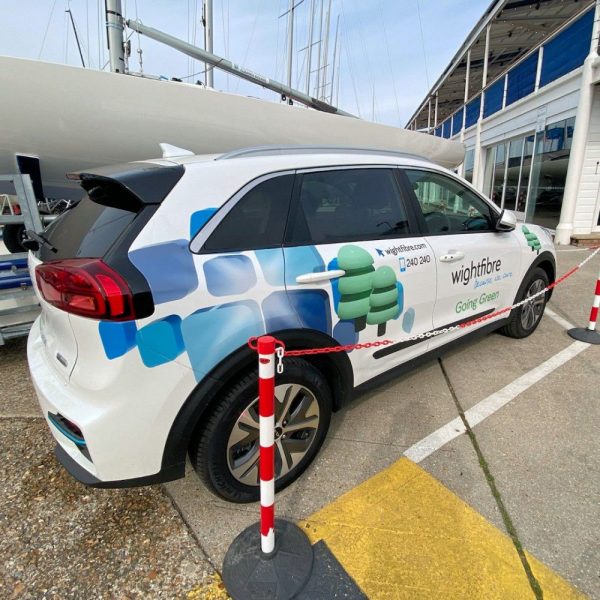Isle of Wight ISP WightFibre Grows Broadband Customers to 21,000

Network operator and broadband ISP WightFibre, which is building a gigabit speed Fibre-to-the-Premises (FTTP) network across the Isle of Wight – just off the South Coast of Hampshire (England), has today revealed that they’ve managed to grow their take-up to 21,000 customers (30% market share).
The operator has already spent over £80m (Dec 2023) – rising to £110m by 2030 – to cover around 80% of the island (70,000 premises) with their new full fibre network (i.e. the ‘Gigabit Island‘ project), which should increase to 86% (74k) of the island by the end of 2024, then 90% by the end of 2025 and 98% by 2027 (c.82,000 premises).
The Government’s (Building Digital UK) Gigabit Broadband Voucher Scheme (GBVS) has also helped to fuel some of their progress in the hardest to reach areas, with over £3.1m in vouchers claimed to date. We should add that WightFibre’s network is roughly 85% built in their own underground ducting, with less than 15% using Openreach’s existing cable ducts and poles (PIA).
Advertisement
John Irvine, CEO of WightFibre, said:
“Our growing customer base and unwavering loyalty speak volumes. We’re not just a provider, we’re rapidly becoming woven into the very fabric of the Isle of Wight. WightFibre’s secret sauce? Localness. It’s what sets us apart, allowing us to deliver exceptional service at competitive prices.”
Andy Matthews, Head of Greenfield at Infracapital, said:
“As WightFibre nears its completion on the Island, we are very pleased with the progress. This is a real success story and the connectivity will bring social inclusion, jobs and many wider benefits to its communities”.
The news represents good progress, even if it is taking a bit longer than originally expected to build, and we’d expect their market share to increase in the future. The main challenge to this will be coming from Openreach (BT), which has already invested £4.5m to cover 15,000 premises across the Isle of Wight (here) and is expected to reach around 45,000 premises by 2026.
Otherwise, WightFibre’s packages start at £28.95 per month for a 150Mbps (symmetric) package, rising to £41.00 for 900Mbps. A social tariff of £19.95 for 100Mbps is available to customers in receipt of means tested benefits, and speeds of 10Gbps are available to business customers.
Mark is a professional technology writer, IT consultant and computer engineer from Dorset (England), he also founded ISPreview in 1999 and enjoys analysing the latest telecoms and broadband developments. Find me on X (Twitter), Mastodon, Facebook, BlueSky, Threads.net and Linkedin.
« UK ISP Association Sets Out Telecoms Priorities for Next Government






















































I think Wight Fibre is the only UK provider to use individual fibre to each house without a split and shared fibre like BT’s GPON which can have up to 64 premises on a split.
Each premise actually has 3 fibres in the cable, but only 1 is used, fibre back to cabinet (point to point) and then fibre from there to the headend.
Bit different when the total population is <150k though, vs the whole of the UK. Has apparently approx 69k dewllings.
NI is the "small" deployment in UK terms and has 822k dwellings. Whilst it's nice to have dedicated links, they'd need:
– Potentially more backhaul, as contention isn't handled on the pon split.
– much more space for the fibers to terminate at. I'd hate to think how much space would be needed to do 3 fibres to every house in the UK (25mill+ dwellings just in England).
Still a very nice deployment if that's how it's been done 🙂
@anonymous At least B4RN and Balquhidder are doign the same. It’s basically BiDi ethernet, symmetric 25Gbps with zero contention in the access layer is possible today.
Isle of Wight’s quite an interesting case, as it’s so clearly demarcated, and little prospects for residential or industrial growth. Openreach look to be late to the party (15k properties RTS in January, apparent aim for 45k?). But with WightFibre build costs of £110m at completion, what does all this mean for the ultimate viability of Wightfibre? If we assume that (a) eventually all RTS properties voluntarily or otherwise go onto FTTP, and (b) that Openreach ISPs have a 50% share amongst the 45k properties but then don’t build out to the balance of the island, then WightFibre would have 47.5k FTTP customers. That’s an asset spend of about £2,300 per customer – can an ISP be profitable with that level of investment? By comparison, Zen seem to bounce along around the break even mark (from continuing business and recurring revenues), and that’s with only £24m of fixed assets including intangibles spread across circa 200k customers.
I’m not writing off Wightfibre, and they appear to be doing a great job, but I wonder whether there’s a true path to profitability?
My guess is that the profitability comes from getting a better than 50% share of the market. Given the pricing and the fact they are way ahead of Openreach in terms of deployment that will help a lot. The population of the Isle of Wight are also quite “funny” when it comes to local, so a local company will have a lot of traction that Openreach won’t. As long as customer service is OK and the pricing remains competative my guess is Openreach will get a pounding.
On my rough and ready assumptions, that £2.3k per customer requires them to have 67% market share across the island! Even allowing a preference for a local brand, I would think my asumptions will turn out to be overly favourable for WightFibre, and in that case the capital investment per paying customer goes up.
If they had a 50% market share across the island, then that’s £3,100 per customer.
30% take up is a great achievement considering the average altnet take up is only 16% and is only just short of Openreach’s 34% (and they’ve had the advantage of an existing user base to migrate to FTTP). Shows the importance of being first in the street. I would suggest that the customer base is likely to be quite loyal as long as the pricing stays competitive.
They are also symmetric unlike BT, and keenly priced compared to BT.
If you just want 150mbps BB down and 150mbps up its only £28.95, with 300mbps up/down at £30.95
Love the analysis Andrew G. When you look beyond the just the balance sheet spend, the total capital consumed in the accounts is £124m (£6k a customer). Like you say, Wight are doing ok and shouldn’t be written off but it’s a challenging set of economics.
Wightfibre have a very long head start over BT for all kinds of high speed internet (were the only high speed option for parts of the island for years), and therefore have a fairly defensible moat against losing existing customers and can market locally effectively for new customers.
Local reporting of the same press release that Marl has used
https://iwobserver.co.uk/gigabit-island-makes-great-advances/